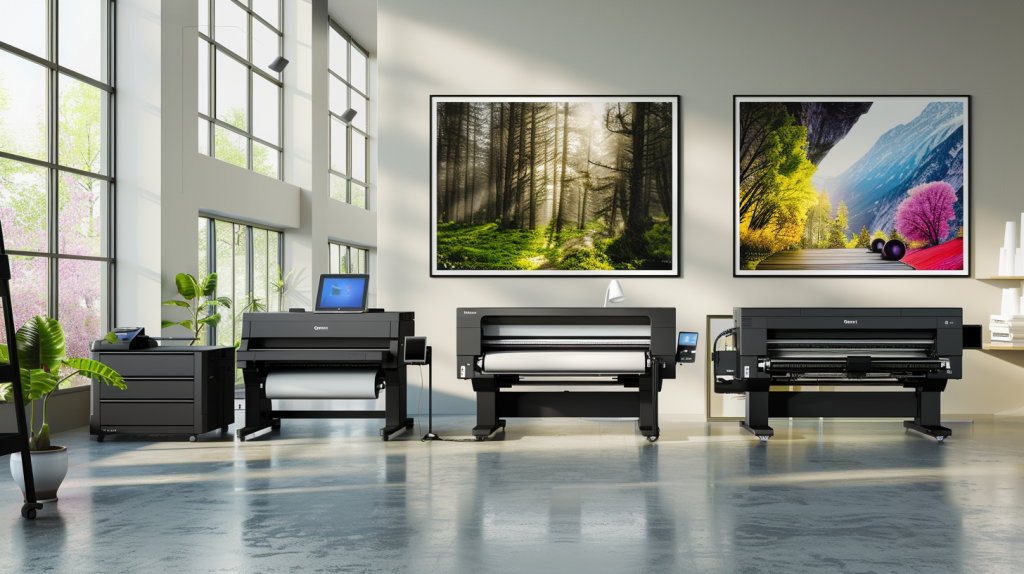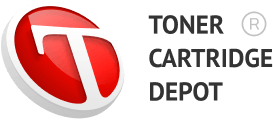
In the world of professional printing, choosing the right wide-format printer can make all the difference in quality, efficiency, and cost. Wide-format printing technology has evolved significantly, and three major players—HP, Canon, and Epson—continue to dominate the market with their innovative solutions. Whether you’re a graphic designer, an architect, or a marketing professional, selecting the right wide-format printer is crucial for your business’s success. This article provides a comprehensive comparison of HP, Canon, and Epson wide-format printers, evaluating key aspects such as cartridge compatibility, print quality, ink and printhead technology, cost efficiency, performance, and environmental impact.
Overview of Wide-Format Printing
What is Wide-Format Printing?
Wide-format printing, also known as large-format printing, refers to printing materials that are larger than the standard size used by typical office printers. These printers can handle widths ranging from 18 inches to over 100 inches, making them ideal for creating banners, posters, murals, maps, technical drawings, and more. Wide-format printers are commonly used in industries such as advertising, architecture, engineering, and graphic design.
Common Applications and Industries
Wide-format printers are indispensable tools in various sectors:
- Advertising and Marketing: For creating eye-catching posters, banners, and signage.
- Architecture and Engineering: For printing detailed blueprints, technical drawings, and CAD designs.
- Photography and Fine Art: For producing high-quality photo prints and reproductions.
- Retail and Event Planning: For designing promotional materials and event backdrops.
The choice of wide-format printer greatly affects the output quality, cost, and efficiency of these applications.
Cartridge Compatibility
Understanding Cartridge Compatibility Across Brands
Cartridge compatibility is a critical factor when choosing a wide-format printer. HP, Canon, and Epson each have different approaches to cartridge design and usage:
- HP: Known for its versatile cartridge systems, HP offers both proprietary and third-party compatible cartridges. However, using third-party cartridges may void warranties and affect print quality.
- Canon: Primarily uses proprietary cartridges designed specifically for their printers. These cartridges ensure high-quality prints but limit flexibility.
- Epson: Offers both proprietary and refillable ink options, allowing for greater flexibility. Epson is well-regarded for its eco-friendly cartridge designs, particularly with its EcoTank series.
Proprietary vs. Third-Party Cartridges
While proprietary cartridges often deliver better performance and reliability, they can be more expensive. Third-party cartridges are more cost-effective but may result in inconsistent print quality and potential printer damage.
Refill Options and Their Implications
Refillable cartridges, particularly in Epson’s EcoTank models, present a sustainable and cost-effective alternative. However, refilling cartridges can be messy and may require more maintenance compared to replacing them.
Print Quality Comparison
Print Quality: The Battle of Resolution and Color Depth
Print quality is a decisive factor when selecting a wide-format printer. It involves multiple aspects, including resolution, color depth, and output consistency:
- HP: Offers high resolutions up to 2400 x 1200 dpi, providing sharp text and vibrant images. HP’s thermal inkjet technology ensures consistent color and detail across prints.
- Canon: Canon printers excel in photographic quality with a resolution of up to 2400 x 1200 dpi. Their printers are equipped with Lucia PRO ink systems that offer superior color gradation and smoothness.
- Epson: Known for their PrecisionCore printheads and high-quality pigment inks, Epson printers deliver a resolution of up to 2880 x 1440 dpi, making them ideal for photographers and fine artists.
Color Accuracy and Output Consistency
When it comes to color accuracy:
- HP uses Vivera inks to achieve a broad color gamut with vibrant and accurate colors.
- Canon provides excellent color accuracy with its 12-color Lucia PRO ink system, reducing the need for reprints.
- Epson printers utilize UltraChrome inks, renowned for their deep blacks and wide color range, making them a top choice for professional photographers and artists.
Ink Technology
Pigment vs. Dye-Based Inks
The type of ink a printer uses can significantly impact the print’s quality, durability, and cost:
- Pigment-Based Inks: Used by both Canon and Epson, pigment inks provide long-lasting, fade-resistant prints. They are ideal for professional-grade prints that need to withstand exposure to light and moisture.
- Dye-Based Inks: More common in HP printers, dye inks are known for their vibrancy and brightness, making them perfect for high-impact graphics but less durable for long-term outdoor use.
Brand-Specific Ink Technologies
- HP: Utilizes both dye and pigment-based inks, providing versatility for different printing needs.
- Canon: Primarily uses pigment-based inks with their Lucia PRO system, designed to deliver archival-quality prints with excellent color fidelity.
- Epson: Leverages its UltraChrome HD and XD2 pigment inks for a combination of vivid colors and longevity, particularly in its SureColor series.
Printhead Technology
The Importance of Printhead Technology
Printhead technology determines the precision and speed of printing. Each brand uses unique technologies:
- HP: Utilizes thermal inkjet printheads, known for their speed and affordability. However, they may require frequent replacements.
- Canon: Features FINE (Full-photolithography Inkjet Nozzle Engineering) printheads that provide exceptional detail and smooth gradations.
- Epson: Leads with PrecisionCore printheads, which deliver high-speed and high-accuracy printing, making them ideal for professional use.
Maintenance Requirements and Longevity
- HP: Thermal printheads are easy to replace but may require more frequent changes.
- Canon and Epson: Printheads are built for longevity but may need periodic maintenance to prevent clogging, especially when using pigment-based inks.
Efficiency and Cost
Ink Efficiency Across Brands
Efficiency is a significant consideration for businesses:
- HP: Offers competitive ink efficiency with its high-capacity cartridges, though running costs can accumulate if using original cartridges.
- Canon: Provides excellent ink efficiency due to its optimized printhead technology and ink utilization.
- Epson: With refillable ink tanks, Epson printers boast the lowest cost per print and high efficiency, especially in high-volume environments.
Cost per Print and Long-Term Implications
While initial costs may seem lower for some printers, considering the long-term cost implications is crucial:
- HP: May have a higher cost per print due to proprietary cartridges but offers reliable service and quality.
- Canon: Balances quality and cost, providing a solid choice for professional photographers.
- Epson: Typically offers the lowest cost per print due to refillable ink tanks, making it ideal for heavy print users.
Performance in Different Applications
Evaluating Performance for Various Print Jobs
The performance of wide-format printers varies depending on the application:
- Photos and Art Prints: Epson and Canon lead with superior color accuracy and high resolution.
- Technical Drawings and CAD Prints: HP is favored for its precision and speed, particularly in technical and architectural prints.
- Signage and Banners: Epson and Canon provide vibrant, durable outputs ideal for signage and outdoor displays.
Color Management and Calibration Features
All three brands offer robust color management and calibration tools to ensure consistent, accurate prints.
Maintenance and Upkeep
Maintenance Requirements for Each Brand
Printer maintenance is an ongoing consideration:
- HP: Easier to maintain with replaceable printheads but may require frequent checks.
- Canon: Requires regular nozzle checks and maintenance, but provides high reliability.
- Epson: Needs occasional cleaning to prevent nozzle clogging, especially with pigment inks.
Software and Driver Support
All three brands offer comprehensive software suites and regular driver updates to ensure compatibility with the latest operating systems and design software.
Environmental Considerations
The Environmental Impact of Wide-Format Cartridges
Eco-friendliness is becoming increasingly important in technology choices:
- HP: Offers a recycling program called “HP Planet Partners” for used cartridges.
- Canon: Provides the “Canon Recycling Program” for ink cartridges and promotes energy-efficient models.
- Epson: Known for its EcoTank models that significantly reduce cartridge waste, Epson also offers recycling and energy-efficient options.
Energy Efficiency and Eco-Friendly Initiatives
All three brands have invested in energy-efficient technologies, with Energy Star certifications being standard across most models.
Pros and Cons Summary
| Feature | HP | Canon | Epson |
| Print Quality | High resolution, vibrant colors | Excellent photographic quality | Superior color depth, ideal for art |
| Ink Technology | Dye and pigment, versatile | Pigment-based, archival quality | Pigment-based, high longevity |
| Printhead Technology | Thermal, replaceable | FINE technology, precise | PrecisionCore, high accuracy |
| Cost Efficiency | Moderate to high | Moderate | Low, especially with EcoTank models |
| Environmental Impact | Recycling program, energy-efficient | Recycling program, energy-efficient | EcoTank system, minimal waste |
Selecting the optimal wide-format printer among HP, Canon, and Epson requires careful consideration of your specific requirements:
- Epson and Canon excel in producing high-quality photo and art prints, making them ideal for creative professionals and photography enthusiasts.
- HP stands out for its efficiency in generating technical drawings and rapid output, particularly beneficial for engineering and architectural firms.
- Epson offers superior value for high-volume printing scenarios, thanks to its innovative refillable ink systems, which can significantly reduce long-term operational costs.
It’s crucial to evaluate these options based on a comprehensive set of criteria beyond initial investment. Factors such as long-term efficiency, print quality consistency, and environmental sustainability should play key roles in your decision-making process.
To make an informed decision:
- Conduct in-depth research by exploring the detailed specifications available on the official HP, Canon, and Epson websites.
- For tailored recommendations, consider reaching out to the respective customer support teams, who can provide insights based on your specific use case.
- Stay informed about the latest advancements in wide-format printing technology by subscribing to our newsletter.
Toner Cartridge Depot is committed to supporting your wide-format printing needs. We offer an extensive range of cartridges compatible with HP, Canon, and Epson wide-format printers. Our commitment to fast delivery and competitive pricing ensures that you receive a reliable and cost-effective solution for all your cartridge requirements, regardless of your chosen brand or model.
